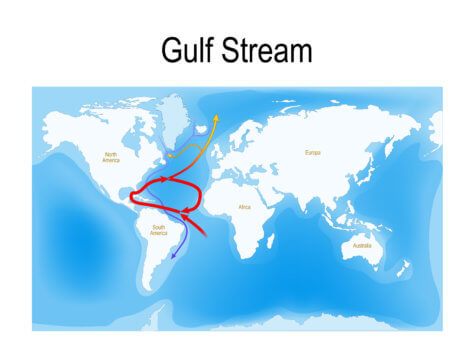POTSDAM, Germany — The Gulf Stream System is at its weakest in 1,000 years due to climate change, reveals new research. The ocean current that brings warm water and shapes weather patterns from the Gulf of Mexico to Europe is slowing down in an unprecedented way, say scientists.
Since the 1950s, the current has slowed by about 15 percent. Experts warn that by 2100, the Gulf Stream System will weaken further by 34 to 45 percent, becoming dangerously close to the tipping point at which the flow becomes unstable. If this happens, the U.S. east coast will face dangerously rising sea levels. Western Europe would also be plunged into a deep freeze in winters with brutal ice storms and the average temperature dropping by 10 degrees Celsius. Summers would be scorching hot, warn scientists.
For the study, researchers from Ireland, Britain and Germany mapped the history of the Gulf Stream System, also known as the Atlantic Meridional Overturning Circulation (AMOC) from proxy data like ocean sediments and ice cores.

“The Gulf Stream System works like a giant conveyor belt, carrying warm surface water from the equator up north, and sending cold, low-salinity deep water back down south,” says co-author Stefan Rahmstorf, a professor from the Potsdam Institute for Climate Impact Research, in a statement. “It moves nearly 20 million cubic meters of water per second, almost a hundred times the Amazon flow. For the first time, we have combined a range of previous studies and found they provide a consistent picture of the AMOC evolution over the past 1600 years.
“The study results suggest that it has been relatively stable until the late 19th century,” he adds. “With the end of the little ice age in about 1850, the ocean currents began to decline, with a second, more drastic decline following since the mid-20th century.”
Statistician Dr. Niamh Cahill from Maynooth University in Ireland tested the data and found the weakness in the Gulf Stream System to be significant. “Assuming that the processes measured in proxy records reflect changes in AMOC, they provide a consistent picture, despite the different locations and time scales represented in the data,” she explains. “The AMOC has weakened unprecedentedly in over 1000 years.”
So why will a slowing system lead to dangerous sea levels?
“The northward surface flow of the AMOC leads to a deflection of water masses to the right, away from the US east coast,” explains Dr. Levke Caesar, part of the Irish Climate Analysis and Research Unit at Maynooth University. “This is due to Earth’s rotation that diverts moving objects such as currents to the right in the northern hemisphere and to the left in the southern hemisphere. As the current slows down, this effect weakens and more water can pile up at the US east coast, leading to an enhanced sea-level rise.”
The study is published in Nature Geoscience.
SWNS writer Joe Morgan contributed to this report.
